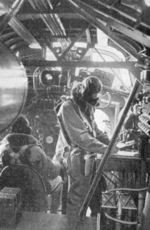Harrow
| Country | United Kingdom |
| Manufacturer | Handley Page Limited |
| Primary Role | Heavy Bomber |
| Maiden Flight | 10 October 1936 |
Contributor: Alan Chanter
ww2dbaseDesigned, in 1936, by German aeronautical engineer Gustav Lachmann the Handley Page HP.54 Harrow was a twin-engine high-wing monoplane intended for use as a troop transport, but it would instead enter RAF service in 1937 as an interim bomber to meet Specification B2/34 that required a hundred aircraft to replace the obsolescent Handley Page Heyford and the lumbering Vickers Virginia biplanes. As such it would be equipped with a standard defensive armament of four 0.303-inch machine-guns in nose, dorsal and tail turrets. For the Harrow, Handley Page initiated a new production system whereby small parts would be to be manufactured by sub-contractors, which offered big advantages in both construction and repair. The first thirty-nine were Harrow Mk.I aircraft with 850-horsepower Bristol Pegasus X engines that produced a maximum speed of 190 miles per hour, but the following sixty-one aircraft, designated Harrow Mk.II, were fitted with a more powerful 925-horsepower Pegasus XX engines that allowed an additional 10 miles per hour.
ww2dbaseThese aircraft were issued to five squadrons of No. 3 Group based in Norfolk in eastern England, United Kingdom. No. 214 (Federated Malay States) Squadron at RAF Feltwell in Norfolk was the first to be equipped with Harrows in January 1937 to replace their Virginias. By the end of the year two other squadrons were converted - No. 37 Squadron (also at RAF Feltwell) in April and No. 115 Squadron at nearby RAF Marham in June. Finally in April 1938, No. 75 Squadron and No. 215 Squadron arrived at RAF Honington in Suffolk County, England, from RAF Driffield in Yorkshire, England to exchange their Virginias for Harrows, the last of which came off the production line in December 1937. Between 1936 and 1937, 100 of these aircraft were built.
ww2dbaseThe Harrow would enjoyed only a brief career with Bomber Command, and during the spring of 1939 the Harrows were all exchanged with the Vickers Wellington. The Harrows were then transferred to Transport Command with the deletion of the turrets and bombing equipment. A novel use of the Harrow was as an aerial minelayer trials when, No. 420 Flight was formed at RAF Middle Wallop in the county of Hampshire in southern England in October 1940 to carry out experiments under the codename "Panders". These aircraft were to deliver the "Long Aerial Mine" which consisted of many small explosive charges suspended from parachutes which could be dropped into the path of approaching enemy bombers. Although four or five "kills" may have been achieved, after three months it was decided that the idea was impractical and the flight was reformed as No. 3 Squadron with Wellingtons and Havocs.
ww2dbaseNo. 271 squadron was formed at RAF Doncaster in Yorkshire on 1 May 1940 to operate in the transport role. It was equipped with a mix of Harrows, Bombays and an assortment of other impressed civilian aircraft, and although most of the other types had been replaced by 1944 a flight Harrows was retained for troop transport and casualty evacuation duties. The squadron's headquarters moved to RAF Down Ampney, Gloucestershire, England in February 1944 from where its Dakotas and Harrows supported the Allied forces in north-west Europe; two of the Harrows notably evacuating wounded from the Arnhem operation in the Netherlands in September 1944. Seven of the flight's Harrows were lost on 1 January 1945, during the Luftwaffe's surprise attack on Allied Air Baes in Europe and the flight was subsequently re-equipped with Dakotas in May. The surviving Harrows were retired in 1946.
ww2dbaseSources:
David Mondey: British Aircraft of World War II (Hamlyn Publishing, 1982)
Graham Smit: Heroes of Bomber Command-Suffolk (countryside Books, 2008)
World Aircraft Information Files, File 896/06 (Aerospace Publishing Periodical)
Chaz Bowyer: Royal Air Force Handbook 1939-1945 (Ian Allsn Ltd., 1984)
Last Major Revision: Jan 2023
Harrow Timeline
| 10 Oct 1936 | Harrow aircraft took flight for the first time. |
SPECIFICATIONS
Harrow
| Machinery | Two Bristol Pegasus XX 9cyl single-row air-cooled Radial engines rated at 925hp |
| Armament | 1x0.303in nose turret Lewis machine gun, 1x0.303in dorsal turret Lewis machine gun, 2x0.303in tail Lewis machine gun, 1,361kg of bombs |
| Crew | 5 |
| Span | 26.95 m |
| Length | 25.04 m |
| Height | 5.92 m |
| Wing Area | 101.26 m² |
| Weight, Empty | 6,169 kg |
| Weight, Loaded | 10,433 kg |
| Speed, Maximum | 322 km/h |
| Speed, Cruising | 262 km/h |
| Service Ceiling | 22,800 m |
| Range, Normal | 2,012 km |
Photographs
 |  |
Please consider supporting us on Patreon. Even $1 per month will go a long way! Thank you. Please help us spread the word: Stay updated with WW2DB: |

- » Wreck of Teruzuki Found (27 Jul 2025)
- » USS Orlean's Bow Found (22 Jul 2025)
- » The Emperor of Japan Planned to Honor WW2-era Japanese POWs in Mongolia (4 Jul 2025)
- » US State Lawmaker John Winter Caught Using Racial Slur "Jap" and Apologized (11 Jun 2025)
- » US Government Plans to Purge WW2 Information (17 Mar 2025)
- » See all news
- » 1,182 biographies
- » 337 events
- » 45,119 timeline entries
- » 1,249 ships
- » 350 aircraft models
- » 207 vehicle models
- » 376 weapon models
- » 123 historical documents
- » 261 facilities
- » 470 book reviews
- » 28,415 photos
- » 365 maps
Lt. Gen. Lewis B. "Chesty" Puller, at Guadalcanal